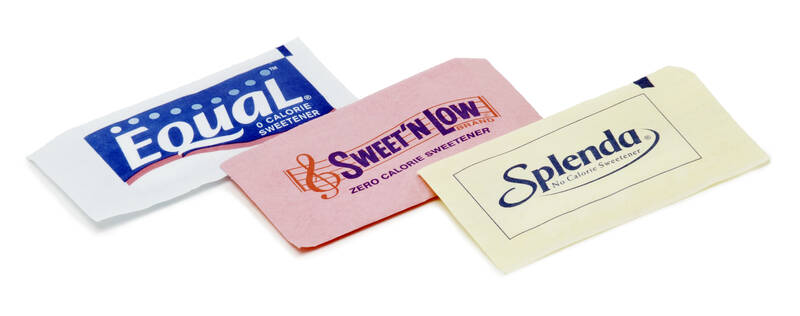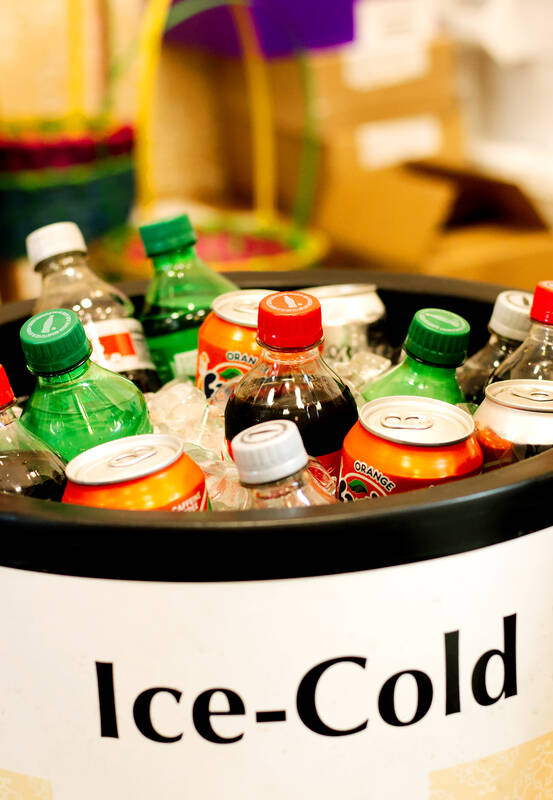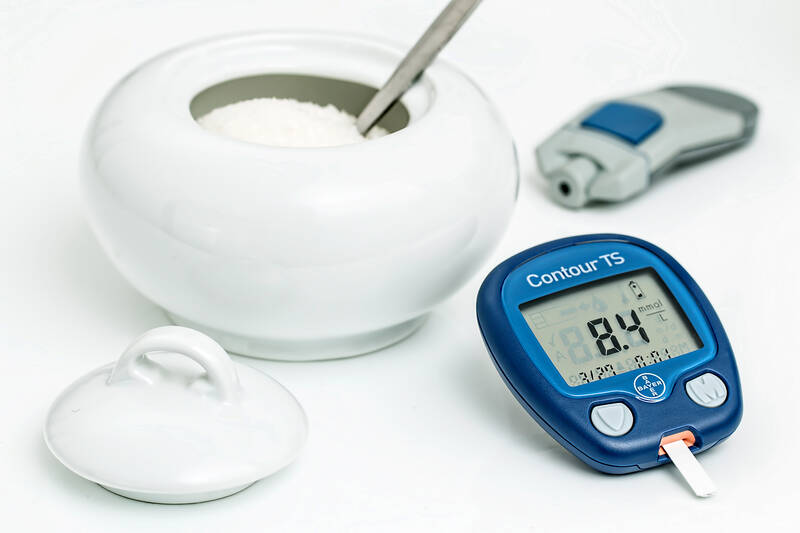Artificial sweeteners may not help people lose weight, the World Health Organization said in new guidelines that warn against products like diet sodas.
The WHO’s advice is based on a scientific review that found products containing aspartame and stevia — often marketed as diet foods — likely do not help reduce body fat in the long term.
“People should reduce the sweetness of the diet altogether,” Francesco Branca, WHO director for nutrition and food safety, said Monday last week.

Photo: Wikimedia Commons 照片:維基共享資源
Artificial sweeteners were also linked with higher risk of developing type 2 diabetes and cardiovascular disease, as well as of dying, according to the WHO.
The new guidance applies to all non-sugar sweeteners, including stevia derivatives and sucralose. Such products have become widely used and are commonly added to processed foods and beverages, like diet soda, or sold on their own.
‘Not essential’

Photo: Pixabay 照片:Pixabay
Artificial sweeteners “are not essential dietary factors and have no nutritional value,” Branca said. They are also often used to replace sugar in highly processed foods and drinks, and therefore may encourage low-quality diets.
Popular consumer products like Diet Coke and Diet Snapple, rebranded last year to Zero Sugar Snapple, contain aspartame. Keurig Dr Pepper Inc, the maker of Snapple, did not immediately respond to a request for comment. The Coca-Cola Co referred Bloomberg to a statement from the Calorie Control Council that called artificial sweeteners “a critical tool that can help consumers manage body weight and reduce the risk of non-communicable diseases.”
The International Sweeteners Association, another industry group, said in a statement that it is “disappointed that the WHO’s conclusions are largely based on low-certainty evidence from observational studies.” Observational studies often do not have safeguards like comparison groups, which can introduce bias into findings.

照片:Pixabay
The new recommendation applies to everyone except those who already have diabetes, the WHO said. The agency issued a draft guideline against sweeteners in July last year, and opened it up to public consultation.
The WHO has previously advised adults and kids to limit their sugar intake to 10 percent of total energy consumption, highlighting the connection between lower sugar intake and lower body weight.
(Bloomberg)
根據世界衛生組織發布的新指南,人工甜味劑(代糖)對減重可能並無幫助,該指南警告說,不要飲用健怡無糖汽水等產品。
世衛該建議是基於一項科學審查,該審查發現含有阿斯巴甜及甜葉菊的產品——通常作為減肥食品銷售——從長遠來看可能無助於減少體內脂肪。
「我們應把飲食中的甜味整個減少」,世衛營養及食品安全主任弗朗切斯可.布蘭卡上週一表示。
據世衛稱,人工甜味劑可能會增加罹患第二型糖尿病、心血管疾病及死亡之風險。
新指南適用於所有非糖類之甜味劑,包括甜葉菊衍生物及三氯蔗糖〔俗稱蔗糖素〕。這類產品已廣為使用,通常添加於加工食品及無糖汽水之類的飲料中,或者單獨出售。
「非必需品」
人工甜味劑「並非必需的飲食要素,也沒有營養價值」,布蘭卡說。它們還經常用於替代高度加工食品及飲料中的糖分,因此可能會鼓勵低品質飲食。
受歡迎的消費產品,如健怡可樂與健怡思樂寶飲品(去年更名為零糖思樂寶飲品),含有阿斯巴甜。面對詢問,思樂寶製造商克里胡椒博士公司(Keurig Dr Pepper Inc.)並未立即做出回應。可口可樂公司則向彭博社提供了「卡路里控制協會」的一份聲明,該聲明說人工甜味劑是「可幫助消費者控制體重與降低非傳染性疾病風險之重要工具」。
另一個業界組織「國際甜味劑協會」透過一份聲明表示,它「對世衛之結論主要基於低確定性證據之觀察性研究感到失望」。觀察性研究通常沒有對照組之類的保障措施,這可能會導致偏差的研究結果。
世衛表示,新的建議適用於所有人,除了糖尿病患者以外。世衛去年七月發布了一份指南草案,反對使用甜味劑,並公開徵求意見。
世衛之前曾建議成人及兒童將糖分攝取量限制在總能量消耗的百分之十,強調減少糖分攝取與降低體重之間的關聯。
(台北時報林俐凱編譯)

In an effort to fight phone scams, British mobile phone company O2 has introduced Daisy, an AI designed to engage phone con artists in time-wasting conversations. Daisy is portrayed as a kindly British granny, exploiting scammers’ tendency to target the elderly. Her voice, based on a real grandmother’s for authenticity, adds to her credibility in the role. “O2” has distributed several dedicated phone numbers online to direct scammers to Daisy instead of actual customers. When Daisy receives a call, she translates the scammers’ spoken words into text and then responds to them accordingly through a text-to-speech system. Remarkably, Daisy

Bilingual Story is a fictionalized account. 雙語故事部分內容純屬虛構。 Emma had reviewed 41 resumes that morning. While the ATS screened out 288 unqualified, she screened for AI slop. She could spot it a mile away. She muttered AI buzzwords like curses under her breath. “Team player.” “Results-driven.” “Stakeholder alignment.” “Leveraging core competencies.” Each resume reeked of AI modeling: a cemetery of cliches, tombstones of personality. AI wasn’t just changing hiring. It was draining the humanity from it. Then she found it: a plain PDF cover letter. No template. No design flourishes. The first line read: “I once tried to automate my

Every May 1, Hawaii comes alive with Lei Day, a festival celebrating the rich culture and spirit of the islands. Initiated in 1927 by the poet Don Blanding, Lei Day began as a tribute to the Hawaiian custom of making and wearing leis. The idea was quickly adopted and officially recognized as a holiday in 1929, and leis have since become a symbol of local pride and cultural preservation. In Hawaiian culture, leis are more than decorative garlands made from flowers, shells or feathers. For Hawaiians, giving a lei is as natural as saying “aloha.” It shows love and

1. 他走出門,左右看一下,就過了馬路。 ˇ He walked outside, looked left and right, and crossed the road. χ He walked outside and looked left and right, crossed the road. 註︰並列連接詞 and 在這句中連接三個述語。一般的結構是 x, y, and z。x and y and z 是加強語氣的結構,x and y, z 則不可以。 2. 他們知道自己的弱點以及如何趕上其他競爭者。 ˇ They saw where their weak points lay and how they could catch up with the other competitors. χ They saw where their weak points lay and how to catch up with the other competitors. 註:and 一般連接同等成分,結構相等的單詞、片語或子句。誤句中 and 的前面是子句,後面是不定詞片語,不能用 and 連接,必須把不定詞片語改為子句,and 前後的結構才相等。 3. 她坐上計程車,直接到機場。 ˇ She took a cab, which took her straight to the airport. ˇ She took a cab and it took her straight